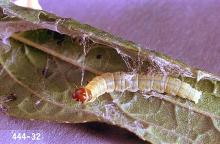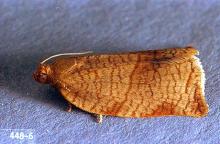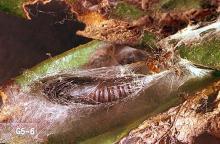Archips rosana
Pest description and crop damage Adult moths are 0.5 to 0.75 inch long, dark brown, with darker transverse lines on the forewings. The larvae are green with a light to dark brown head. Damage begins early in spring and includes rolling of leaves as well as feeding on foliage and buds. There is one generation each season.
Biology and life history This leafroller overwinters as eggs laid on the bark or limbs in irregular flat masses which appear grayish by spring. Eggs hatch in spring as buds are opening. The larvae feed for 4 to 6 weeks, then pupate in the rolled leaves and emerge as moths in early summer. The overwintering eggs are laid on twigs and branches in July.
Pest monitoring Start checking for larvae around mid-March by inspecting three terminals per tree and three leaf clusters per terminal for tightly rolled leaves and feeding damage on new growth. Each terminal is a sampling unit. Treat for larvae when infestation level is 20 to 25%. Check for adults by using one pheromone trap for each 5 acres, place 6 ft high in the tree canopy starting in mid-May. Treat for adults when catch is 40 moths per week.
Management-biological control
Very low temperatures in winter significantly reduce overwintering populations of larvae. Spiders and parasitic wasps, as well as predators like the brown lacewing, greatly reduce leafroller populations throughout the year. Typically, biological control is sufficient to manage leafrollers and chemical control is rarely necessary. There are numerous parasitoid wasps that target the later larval stages.
Management-cultural control
Home orchardists: Hand-pick and destroy rolled leaves containing larvae or pupae.
Management-chemical control: HOME USE
Spray in spring after overwintering eggs hatch, at about the time leaves are 0.75 to 1 inch long. Control is much more effective if sprays are applied when larvae are small. Avoid treating when larvae are mature; damage will already have occurred and natural enemies will be adversely affected.
- azadirachtin (neem oil)-Some formulations are OMRI-listed for organic use.
- Bacillus thuringiensis var. kurstaki-Some formulations are OMRI-listed for organic use.
- carbaryl (Sevin)
Management-chemical control: COMMERCIAL USE
Make applications in spring after overwintering eggs hatch, about the time leaves are about 0.75 to 1 inch. Control is more effective if insecticides are applied when worms are small. Note that this pest has not been occurring at levels that would require treatment in recent years.
- Bacillus thuringiensis var. kurstaki-See label for rates. PHI 0 days. Apply with spreader-sticker. Some formulations are OMRI-listed for organic use.
- bifenthrin (Brigade WSB, other generics) at 0.05 to 0.2 lb ai/A. PHI 7 days. REI 12 hr.
- carbaryl (Sevin XLR Plus) at 0.5 to 1.25 quarts/100 gal water (2 to 5 quarts/A). PHI 14 days. REI 12 hr. May cause rapid increase of aphid populations 3-4 weeks after application. Extremely toxic to aquatic invertebrates.
- diazinon (Diazinon AG 500) at 1 pint/250 to 400 gal water per acre. One application per season. PHI 45 days. REI 18 days. WA and OR only.
- diflubenzuron (Dimilin 2L) at 12 to 16 fl oz/A. PHI 28 days. REI 12 hr. Extremely toxic to aquatic invertebrates. Do not apply within 25 ft of bodies of water.
- emamectin benzoate (Proclaim) at 3.2 to 4.8 oz/A. PHI 14 days. REI 12 hr.
- fenpropathrin + Bacillus thuringiensis var. kurstaki-(Danitol 2.4 EC + DiPel DF) at 10.3 to 21.3 oz/A (0.2 to 0.4 lb ai/A) + 0.5 to 2.0 lb/A. PHI 3 days. REI 24 hr. At least 50 gal water for ground applications. Note buffer requirements for use near aquatic zones.
- lambda-cyhalothrin-
- Warrior II/ Grizzly Too at 1.28 to 2.56 fl oz/A (0.02 to 0.04 lb ai/A). PHI 14 days. REI 24 hr. Do not exceed 0.16 lb ai/A per season or 0.12 lb ai post bloom.
- LambdaStar/ Drexel L-C at 2.56 to 5.12 fl oz/A. PHI 14 days. REI 24 hr. Do not exceed 0.16 lb ai/A per season or 0.12 lb ai post bloom.
- methoxyfenozide (Intrepid 2F and generics) at 8 to 16 fl oz/A. PHI 14 days. REI 4 hr. For control of foliar feeding leafroller larvae, apply when larvae are feeding. Most effective crop protection results from application made at the initiation of egg hatch. Do not apply more than 24 fl oz/A per application or 64 fl oz/A (1 lb ai) per season. Do not apply within 25 ft of an aquatic habitat, 150 ft if applied by air.
- methoxyfenozide + spinetoram (Intrepid Edge) at 6 to 12 oz/A. Apply at initiation of egg hatch, if necessary reapply after 14 to 21 days, but not before 14 days. PHI 7 days. REI 4 hr. No more than 12 fl oz/A/season.
- permethrin-
- Ambush 25W at 12.8 to 25.6 oz/A. PHI 14 days. REI 12 hr. Do not graze treated orchards. Extremely toxic to fish and aquatic habitat.
- Ambush 2E at 0.8 to 1.6 pints/A. PHI 14 days. REI 12 hr. Do not graze treated orchards. Extremely toxic to fish and aquatic habitat.
- Pounce 3.2 EC at 0.5 to 1 pint/A. PHI 14 days. REI 12 hr. Do not graze treated orchards. Extremely toxic to fish and aquatic habitat.
- spinosyns-
- spinetoram (Delegate WG) at 1.5 to 1.75 oz/100 gal water (4.5 to 7 oz/A). PHI 14 days. Apply no less than one week apart, with a maximum 4 applications per season.
- spinosad (Entrust SC) at 4 to 10 oz/A (0.06 to 0.16 lb ai/A). PHI 1 days. REI 4 hr. OMRI-listed for organic use.
- spinosad (Success Naturalyte) at 4 to 10 oz/A in 100 gal water (0.06 to 0.16 lb ai/A). PHI 1 day. REI 4 hr. Do not exceed 29 oz/A per season.





